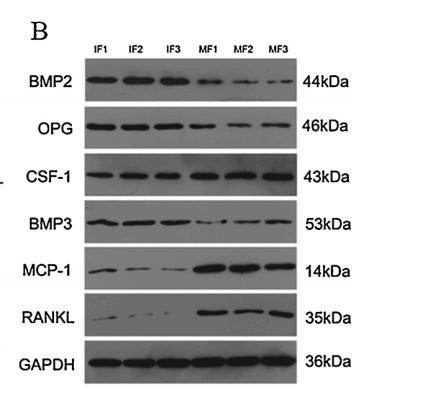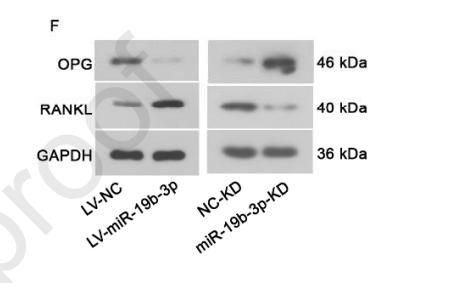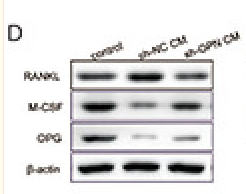Osteoprotegerin Antibody - #DF6824
| Product: | Osteoprotegerin Antibody |
| Catalog: | DF6824 |
| Description: | Rabbit polyclonal antibody to Osteoprotegerin |
| Application: | WB IHC IF/ICC |
| Cited expt.: | WB, IHC |
| Reactivity: | Human, Mouse, Rat |
| Prediction: | Pig, Bovine, Horse, Sheep, Rabbit, Dog, Chicken |
| Mol.Wt.: | 45~60kDa; 46kD(Calculated). |
| Uniprot: | O00300 |
| RRID: | AB_2838784 |
Related Downloads
Protocols
Product Info
*The optimal dilutions should be determined by the end user. For optimal experimental results, antibody reuse is not recommended.
*Tips:
WB: For western blot detection of denatured protein samples. IHC: For immunohistochemical detection of paraffin sections (IHC-p) or frozen sections (IHC-f) of tissue samples. IF/ICC: For immunofluorescence detection of cell samples. ELISA(peptide): For ELISA detection of antigenic peptide.
Cite Format: Affinity Biosciences Cat# DF6824, RRID:AB_2838784.
Fold/Unfold
MGC29565; OCIF; OPG; Osteoclastogenesis inhibitory factor; Osteoprotegerin; PDB5; TNF receptor superfamily member 11b; TNFRSF 11B; TNFRSF11B; TR 1; TR1; TR11B_HUMAN; Tumor necrosis factor receptor superfamily member 11B;
Immunogens
A synthesized peptide derived from human Osteoprotegerin, corresponding to a region within the internal amino acids.
Highly expressed in adult lung, heart, kidney, liver, spleen, thymus, prostate, ovary, small intestine, thyroid, lymph node, trachea, adrenal gland, testis, and bone marrow. Detected at very low levels in brain, placenta and skeletal muscle. Highly expressed in fetal kidney, liver and lung.
- O00300 TR11B_HUMAN:
- Protein BLAST With
- NCBI/
- ExPASy/
- Uniprot
MNNLLCCALVFLDISIKWTTQETFPPKYLHYDEETSHQLLCDKCPPGTYLKQHCTAKWKTVCAPCPDHYYTDSWHTSDECLYCSPVCKELQYVKQECNRTHNRVCECKEGRYLEIEFCLKHRSCPPGFGVVQAGTPERNTVCKRCPDGFFSNETSSKAPCRKHTNCSVFGLLLTQKGNATHDNICSGNSESTQKCGIDVTLCEEAFFRFAVPTKFTPNWLSVLVDNLPGTKVNAESVERIKRQHSSQEQTFQLLKLWKHQNKDQDIVKKIIQDIDLCENSVQRHIGHANLTFEQLRSLMESLPGKKVGAEDIEKTIKACKPSDQILKLLSLWRIKNGDQDTLKGLMHALKHSKTYHFPKTVTQSLKKTIRFLHSFTMYKLYQKLFLEMIGNQVQSVKISCL
Predictions
Score>80(red) has high confidence and is suggested to be used for WB detection. *The prediction model is mainly based on the alignment of immunogen sequences, the results are for reference only, not as the basis of quality assurance.
High(score>80) Medium(80>score>50) Low(score<50) No confidence
Research Backgrounds
Acts as decoy receptor for TNFSF11/RANKL and thereby neutralizes its function in osteoclastogenesis. Inhibits the activation of osteoclasts and promotes osteoclast apoptosis in vitro. Bone homeostasis seems to depend on the local ratio between TNFSF11 and TNFRSF11B. May also play a role in preventing arterial calcification. May act as decoy receptor for TNFSF10/TRAIL and protect against apoptosis. TNFSF10/TRAIL binding blocks the inhibition of osteoclastogenesis.
N-glycosylated. Contains sialic acid residues.
The N-terminus is blocked.
Secreted.
Highly expressed in adult lung, heart, kidney, liver, spleen, thymus, prostate, ovary, small intestine, thyroid, lymph node, trachea, adrenal gland, testis, and bone marrow. Detected at very low levels in brain, placenta and skeletal muscle. Highly expressed in fetal kidney, liver and lung.
Research Fields
· Environmental Information Processing > Signaling molecules and interaction > Cytokine-cytokine receptor interaction. (View pathway)
· Organismal Systems > Development > Osteoclast differentiation. (View pathway)
References
Application: WB Species: mouse Sample: MC3T3-E1
Application: WB Species: rat Sample: bone marrow
Restrictive clause
Affinity Biosciences tests all products strictly. Citations are provided as a resource for additional applications that have not been validated by Affinity Biosciences. Please choose the appropriate format for each application and consult Materials and Methods sections for additional details about the use of any product in these publications.
For Research Use Only.
Not for use in diagnostic or therapeutic procedures. Not for resale. Not for distribution without written consent. Affinity Biosciences will not be held responsible for patent infringement or other violations that may occur with the use of our products. Affinity Biosciences, Affinity Biosciences Logo and all other trademarks are the property of Affinity Biosciences LTD.







